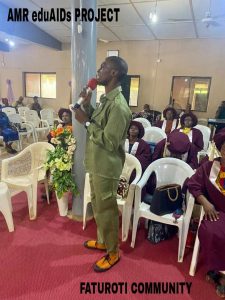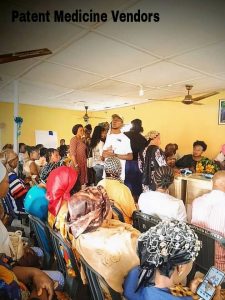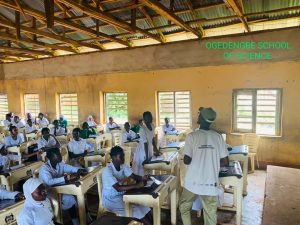October 14th, 2024
Can we Meet you?
I am Ibraheem Olasunkanmi Qoseem, a former youth corps member in Ilesha, Osun State. I am a registered and licensed medical laboratory scientist with Medical Laboratory Science Council of Nigeria(MLSCN). I am passionate about improving healthcare delivery through evidence-based practices and community engagement. I seek to leverage my expertise in laboratory diagnosis, grant writing, health communication and public health promotion to drive impactful health outcome that directly affects the life of the populace.
What Were Your Engagements in Your Place of Assignment?
It is an incontrovertible truism that youth corps member remains a veritable tool for community and largely national development. Like every other corps members, I did what was expected. Apart from my commitment to my primary place of assignment at State Hospital Ilesha by providing quality diagnosis which resulted to improved health outcome of the communities served, I was always on the streets building communities.

Being the president of Sustainable Development Goals Community Development Services group, I led lot of initiatives. As the pioneer leader, I began SDGs-CDS group as a lone and viewd irrelevant group, but we thank God today that we are way more relevant than the traditional groups.
I led free medical services at Secretariat benefited by 100 hundred one people including Ilesha West Chairman and vice, directors, LGI, corps members and other people in celebration of world Tuberculosis Day. I also led SDGs awareness in in four secondary schools in Ilesha benefited by more than five hundred plus. I spearheaded free medical services in partnership with health CDS group at Atakumasa market benefited by 100 hundred five people.

I led sanitation and health hygiene in market place and distributed writing materials to underprivileged schools in Ilesha communities in partnership with Environmental Sanitation and Education CDS groups respectively. During the outreach of Cholera disease, I led sensitization and awareness about the disease at Osogbo Park. The list is endless.
What Other Things did You do?
As much as I take pride in my profession(medical laboratory science) by providing quality laboratory services to assist doctors in saving people’s life. I felt there was need to do more and that was if I can prevent people from being sick. The main reason why I chose development work above clinical practice.
When I was in my place of work, I noticed the pattern of resistance infections, which I investigated to be as a result misuse and abuse of antimicrobial drugs within the communities. After the findings, I realized that lack of community awareness about the consequences of this bad practices is a great propeller. In my resolve to make meaningful impact, that was why I launched an initiative tagged, Antimicrobial Resistance Educational Aids -AMR eduAIDs.

It was a pioneering educational initiative on Antimicrobial Resistance, where I led sensitization and awareness in ten communities, five secondary schools, engaged patent medicine vendors and leveraged on radio station to reach wider audience of Ilesha city. Not only that, every community engaged were tested free for malaria, hepatitis B, HIV, blood sugar, blood pressure check and appropriate treatments.
How Confident are you About the Impact of Your Work-AMR eduAIDs Project?
As a trained SDG advocate, I did not just enter the community to implement my project activities, there were procedures been followed that enabled me to monitor and evaluate the impacts and guaranteed me sustainability. Most importantly, I was not going to the community to do things for them, but we did it together.
Recounting the impact of my project, I will look at it from the lens of SDGs:
1- On SDGs 3(Good Health and Well-being): The project has successfully contributed to combating communicable diseases by promoting the proper use of antibiotics and educating ten communities on antimicrobial resistance. This will help to reduce infections that can become harder to treat due to resistance in Ilesha city.
While the free health screenings for the communities including malaria, HIV, hepatitis B, blood sugar, and blood pressure has helped in advancing the goal of achieving universal health
coverage, particularly in underserved communities. And Strengthening the capacity of communities and healthcare professionals, such as Patent Medicine Vendors (PMVs), in AMR stewardship will directly enhance the capacity for early
warning, risk reduction, and management of national and global health risks.
2. On SDG 4(Quality Education): By educating 280 students on AMR, the project has promoted knowledge on public health awareness and the responsible use of medical resources. Empowering students to become AMR Champions will also help spread this knowledge across schools and communities.
Target. The initiative promotes inclusive and equitable education by engaging schools in underserved areas, ensuring that students understand health-related issues like AMR.
3. On SDG 6(Clean Water and Sanitation): Although the primary focus of the project is on health and AMR education, raising awareness about antimicrobial misuse can have indirect effects on water quality. Antibiotic misuse and resistance can lead to environmental contamination, as resistant bacteria can enter
water systems. The project helps mitigate these risks by educating communities on proper drug disposal and the effects of resistance.
4. On SDG 8(Decent Work and Economic Growth): The training of 150 PMVs promotes decent work by improving their knowledge and capacity to provide better healthcare services, which in turn boosts local economies by ensuring that health systems are more sustainable and efficient. Improved healthcare also enhances the productivity of the working population.
5. On SDG 10(Reduced Inequality): The project’s outreach to underserved communities like Ilukosi and Moroko ensures that health education and free testing services reach those who are often left behind in healthcare interventions. This helps to reduce inequality in access to health resources and knowledge.
6. On SDG 12(Responsible Consumption and Production): The project promotes the responsible use of antibiotics, helping to reduce the environmental impact of antibiotic overuse and misuse, which contributes to the growing problem of antimicrobial resistance.
7. On SDG 17(Partnerships for the Goals): The project’s success is rooted in its partnerships with organizations such as DRASA
Health Trust which is the majority funder and supported by the Alliance Against Antimicrobial Resistance, the Champions’ Educational Foundation, Premium Health and Educational Consultancy and Cytobiz Medics; these collaborations leverage resources and expertise, making the project more impactful.
How do you Feel About the Completion of AMR eduAid?
Looking back in my advocacy journey, I can say that I am fulfilled with the level of impact that I have made in Ilesha city. Before my engagement, there was obviously low awareness of Antimicrobial Resistance which I believe had direct impact on people’s health.
My passion and enthusiasm driven by a desire to leave Ilesha better than I met it, that was the reason why I embarked on this project.

Today, this is no more a wishful aspiration, AMR has now become household conversation in Ilesha communities including schools. Ilesha communities now demand testing before prescription, and the practices of keeping medication for future use will stop and unnecessary antibiotic use is decreasing gradually.
What Challenges did You Face During the Project Activities?
Well just like the popular reality, project management is not a straight line thing, I faced so many challenges in the course of the project implementation. Getting a sponsor was my number one challenge. I wrote to more than twenty organizations before finding DRASA Health Trust among many others who eventually took interest in my initiative. Aside that, Other challenges are navigating the nationwide protests (end-bad-governance), managing stakeholder expectations, traditional rites for the late Ilesha King, and dealing with local leaders who demanded financial inducements before mobilization.
What were the Lesson Learned?
Mobilizing the community members especially through community leaders without incentives(this reason may not be general) was not successful but direct street engagement proved more effective. Using media channel such as Timsed proved effective in advancing advocacy’s reach beyond direct community engagement. Incorporating the testing alongside AMR education increased participation as people were
drawn by free testing services. Providing a platform for the students to demonstrate the lesson learned proved effective in assessing impacts.
If Not AMR eduAid, What Could Have Been?
It will definitely be Town Hall meeting on Substance Abuse. The level at which alcohol drinking is normalized in the region is alarming and call for serious concerns by the stakeholders.
What is Your Advice for Others Willing to Embark on Personal Community Development Initiatives?
Community development service initiatives should be purpose-driven and not approached as an all-comers adventure. Your focus should be on solving a genuine community problem with the community, rather than just for them. This collaboration ensures that the project remains sustainable long after you leave.
While funding is often a challenge, the key is to address realistic problems with a strong sustainability plan. When seeking support, don’t approach just anyone; instead, target organizations whose goals align with your project and have a proven track record.
Above all, don’t be motivated by recognition. Let your passion for making a positive impact be the driving force. The satisfaction of knowing you are improving lives should be enough to keep you going, even in stressful moments.
okay
ok this is very important